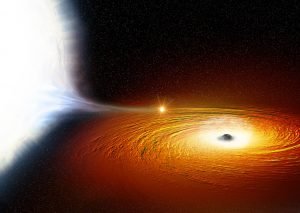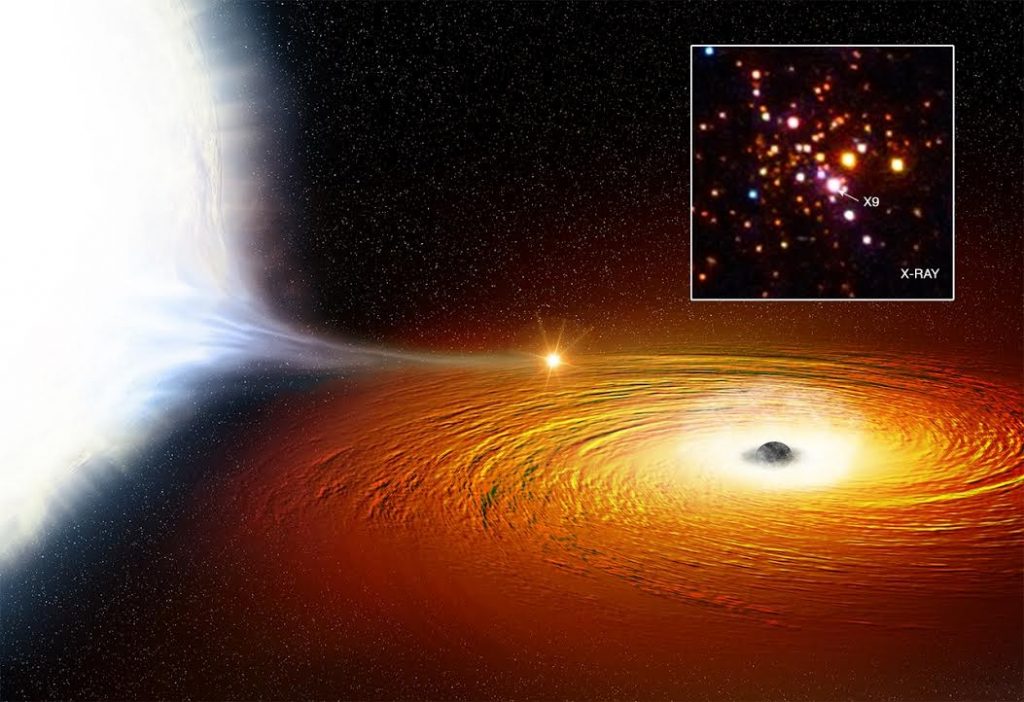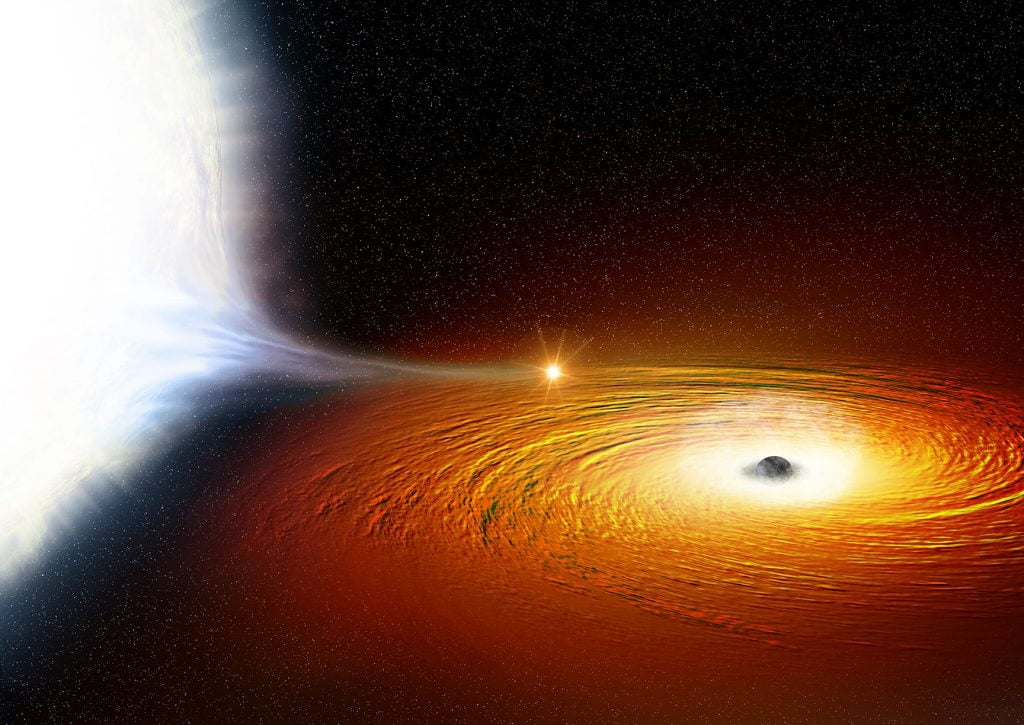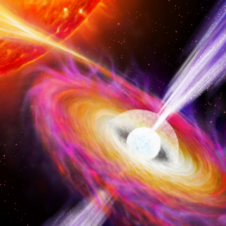Astronomers have found evidence of a star that whips around a likely black hole twice an hour. This could be the tightest orbital dance ever seen by a black hole and a companion star in our own Milky Way galaxy.

An artist’s impression of a white dwarf star (left) in orbit around a black hole and so close that much of its material is being pulled away. There is a hotspot where the gas from the white dwarf hits the disc of matter swirling around the black hole. The black hole itself is surrounded by a cloud of ionised gas, which contains large amounts of oxygen. Credit: X-ray: NASA/CXC/University of Alberta/A.Bahramian et al.; Illustration: NASA/CXC/M.Weiss.
This discovery was made using two of NASA’s space-based telescopes, the Chandra X-ray Observatory and NuSTAR, and CSIRO’s Australia Telescope Compact Array located in New South Wales.
The stellar couple—known as a binary—is located in the globular cluster 47 Tucanae, a dense cluster of stars in our galaxy about 14,800 light years away from Earth.
While astronomers have known about the binary for many years, it wasn’t until 2015 that a team led by researchers from Curtin University and the International Centre for Radio Astronomy Research (ICRAR) found that it was likely made up of a black hole pulling material from a companion star.
New observations from Chandra show the system—known as X9— consistently changes in X-ray brightness every 28 minutes, which is likely the length of time it takes the companion star to make one complete orbit around the black hole.
Along with evidence of large amounts of oxygen in the system, this makes a strong case that X9 contains a white dwarf star orbiting a black hole at just 2.5 times the separation between the Earth and the Moon.
“This white dwarf is so close to the black hole that material is being pulled away from the star and dumped onto a disk of matter around the black hole before falling in,” said first author Dr Arash Bahramian, from the University of Alberta in Canada and Michigan State University in the United States.
“Luckily for this star, we don’t think it will follow this path into oblivion—it should stay in orbit.”
Although the white dwarf does not appear to be in danger of falling in or being torn apart by the black hole, its fate is uncertain.
Associate Professor James Miller-Jones, from Curtin University and ICRAR, said, “We think the star may have been losing gas to the black hole for tens of millions of years and by now has now lost the majority of its mass.”
“Over time, we think that the star’s orbit will get wider and wider as even more mass is lost, eventually turning into an exotic object similar to the famous diamond planet discovered a few years ago,” he said.
How did the black hole get such a close companion? One possibility is that the black hole smashed into a red giant star and as gas from the outer regions of the star were ejected a binary was formed containing a black hole and a white dwarf. The orbit of the binary would then have shrunk as gravitational waves were emitted, until the black hole started pulling material from the white dwarf.
The gravitational waves being produced by the binary system have a frequency too low to be detected by the ground-based facilities that confirmed the existence of gravity waves last year but it is possible that space-based gravity wave observatories in the future could be sensitive enough to detect them.
Co-author Vlad Tudor, also from the Curtin University node of ICRAR, said an alternative theory would involve a neutron star that’s being spun up as material is pulled away by the black hole.
“Much like a spinning top as you pull the string from around its middle to make it go—but this theory doesn’t explain everything we’re seeing here, so our best current explanation is that we’re dealing with a white dwarf in extremely close proximity to a black hole,” he said.
PUBLICATION DETAILS
‘The ultracompact nature of the black hole candidate X-ray binary 47 Tuc X9’, in the Monthly Notices of the Royal Astronomical Society published by Oxford University Press on 14 March 2017.
Click here for the research paper.
MORE INFORMATION
ICRAR
The International Centre for Radio Astronomy Research (ICRAR) is a joint venture between Curtin University and The University of Western Australia with support and funding from the State Government of Western Australia.
Chandra X-Ray Observatory
The Chandra X-ray Observatory is a space-based observatory launched by NASA in July 1999. Chandra is sensitive to X-ray sources 100 times fainter than any previous X-ray telescope, enabled by the high angular resolution of its mirrors. Since the Earth’s atmosphere absorbs the vast majority of X-rays, they are not detectable from Earth-based telescopes—therefore space-based telescopes are required to make these observations.
Nuclear Spectroscopic Telescope Array (NuSTAR)
NuSTAR is a space-based observatory launched by NASA in June 2012. Its primary scientific goals are to conduct a deep survey for black holes a billion times more massive than the Sun, to investigate how particles are accelerated to very high energy in active galaxies, and to understand how the elements are created in the explosions of massive stars by imaging the remains, which are called supernova remnants.
The Australian Compact Array
The Australia Telescope Compact Array (ATCA) is part of the Australia Telescope National Facility which is funded by the Australian Government for operation as a national facility managed by CSIRO. An array of six 22-m antennas used for radio astronomy, it is located in rural NSW about 500 km north-west of Sydney.
CONTACT INFORMATION
Vlad Tudor (ICRAR-Curtin)
Ph: +61 435 595 955 E: vlad.tudor@icrar.org
Associate Professor James Miller-Jones (ICRAR-Curtin)
Ph: +61 488 484 825 E: james.miller-jones@icrar.org
Pete Wheeler +(Media Contact, ICRAR)
Ph: +61 423 982 018 E: pete.wheeler@icrar.org
MULTIMEDIA
Animation: A Quick Look at X9 in 47 Tucanae Courtesy of NASA’s Chandra X-Ray Observatory
Image: An artist’s impression of the ‘X9’ system with inset Chandra observation

An artist’s impression of a white dwarf star (left) in orbit around a black hole and so close that much of its material is being pulled away. Inset is an observation of the host globular cluster, 47 Tucanae, captured by NASA’s Chandra X-ray Observatory. The system (known as X9) is indicated by the arrow, and low, medium, and high-energy X-rays are coloured red, green, and blue respectively. Credit: X-ray: NASA/CXC/University of Alberta/A.Bahramian et al.; Illustration: NASA/CXC/M.Weiss.
Image: An artist’s impression of the ‘X9’ system

An artist’s impression of a white dwarf star (left) in orbit around a black hole and so close that much of its material is being pulled away. There is a hotspot where the gas from the white dwarf hits the disc of matter swirling around the black hole. The black hole itself is surrounded by a cloud of ionised gas, which contains large amounts of oxygen. Credit: X-ray: NASA/CXC/University of Alberta/A.Bahramian et al.; Illustration: NASA/CXC/M.Weiss.
Q&A with Associate Professor James Miller-Jones
1. How surprising was this finding?
Our understanding of astrophysics theory told us that such binary systems, containing a white dwarf in a very tight orbit with a black hole, should exist. So we expected that they should be out there, but until now had not been found clear evidence for one in our own Milky Way Galaxy. There is good evidence for a similar system in another galaxy, Messier 49, which is about 56 million light years away in the Virgo Cluster. We think that one likely has an even shorter orbital period but we don’t have a direct measurement of what its period is; our work is the first time that such a short orbital period has actually been measured in a system that we suspect contains a black hole.
Back in 2015, we predicted that this system (X9 in the globular cluster 47 Tucanae) was likely to be a white dwarf in orbit with a black hole. This was based on its radio brightness, its X-ray brightness, and the absence of bright optical emission from the orbiting star. However, we did not know the exact orbital period. So it was really nice to be able to confirm our predictions with a direct measurement of the period.
2. What’s the closest star around a black hole we’ve found before?
Prior to this discovery, the closest star around any likely black hole was a system known as MAXI J1659-152, which is in an orbit with a 2.4-hour period. If the likely black holes in both systems have similar masses, this would imply an orbit three times larger in physical size than the one we found in X9.
3. It mentions that gravitational waves would have shrunk the orbit of the binary. How would this have happened?
Einstein’s theory of general relativity predicts that as two large masses orbit one another in space, they emit gravitational waves. The larger and closer those masses are, the more quickly energy is lost by gravitational wave emission. The gravitational waves carry energy away from the system. That energy is taken from the orbital energy of the two stars, which shrinks the orbit, in much the same way as a spaceship losing energy due to atmospheric drag will sink into a lower orbit around the Earth.
4. Is it possible for a star to get even closer to a black hole before being torn apart?
In the most likely scenario, this particular star would have first started losing mass to the suspected black hole several tens of millions of years ago when it was much closer, in an orbit with a period of just minutes. Over time, as that star has lost most of its mass, the size of the orbit would have increased, and the rate at which mass has been lost to the black hole would have decreased. The rate of mass loss would once have been a billion times higher. So yes, the star would initially have been much closer to the black hole. How close a star can get to a black hole before starting to lose mass to the black hole depends on the kind of star it is. Big, fluffy giant stars can lose gas to a black hole when they are much further away than small, compact stellar remnants like this white dwarf, whose gravity is strong enough that they are able to hold onto their mass more tightly, so need to get much closer before mass can be torn away. We also think that this star will have been gradually losing mass over tens to hundreds of millions of years; in this case it is not being torn apart in a single cataclysmic event that results in it being shredded into streams of debris, as we have seen in spectacular outbursts from the centres of some external galaxies (known as tidal disruption events). Rather, in this case, we have a steady loss of mass to the black hole over time.

